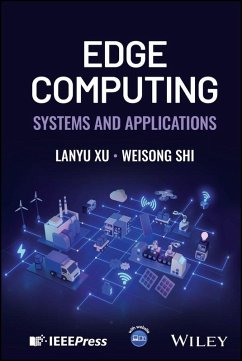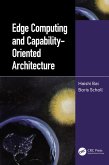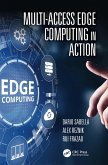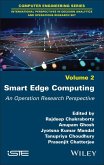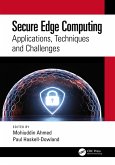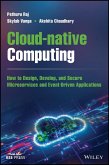116,99 €
116,99 €
inkl. MwSt.
Sofort per Download lieferbar

0 °P sammeln
116,99 €
Als Download kaufen

116,99 €
inkl. MwSt.
Sofort per Download lieferbar

0 °P sammeln
Jetzt verschenken
Alle Infos zum eBook verschenken
116,99 €
inkl. MwSt.
Sofort per Download lieferbar
Alle Infos zum eBook verschenken

0 °P sammeln
- Format: ePub
- Merkliste
- Auf die Merkliste
- Bewerten Bewerten
- Teilen
- Produkt teilen
- Produkterinnerung
- Produkterinnerung

Bitte loggen Sie sich zunächst in Ihr Kundenkonto ein oder registrieren Sie sich bei
bücher.de, um das eBook-Abo tolino select nutzen zu können.
Hier können Sie sich einloggen
Hier können Sie sich einloggen
Sie sind bereits eingeloggt. Klicken Sie auf 2. tolino select Abo, um fortzufahren.

Bitte loggen Sie sich zunächst in Ihr Kundenkonto ein oder registrieren Sie sich bei bücher.de, um das eBook-Abo tolino select nutzen zu können.
Understand the computing technology that will power a connected future
The explosive growth of the Internet of Things (IoT) in recent years has revolutionized virtually every area of technology. It has also driven a drastically increased demand for computing power, as traditional cloud computing proved insufficient in terms of bandwidth, latency, and privacy. Edge computing, in which data is processed at the edge of the network, closer to where it's generated, has emerged as an alternative which meets the new data needs of an increasingly connected world.
Edge Computing offers a thorough…mehr
- Geräte: eReader
- mit Kopierschutz
- eBook Hilfe
- Größe: 14.02MB
Andere Kunden interessierten sich auch für
![Intelligent Scheduling of Tasks for Cloud-Edge-Device Computing Systems (eBook, ePUB) Intelligent Scheduling of Tasks for Cloud-Edge-Device Computing Systems (eBook, ePUB)]() Biao HuIntelligent Scheduling of Tasks for Cloud-Edge-Device Computing Systems (eBook, ePUB)108,99 €
Biao HuIntelligent Scheduling of Tasks for Cloud-Edge-Device Computing Systems (eBook, ePUB)108,99 €![Edge Computing and Capability-Oriented Architecture (eBook, ePUB) Edge Computing and Capability-Oriented Architecture (eBook, ePUB)]() Haishi BaiEdge Computing and Capability-Oriented Architecture (eBook, ePUB)44,95 €
Haishi BaiEdge Computing and Capability-Oriented Architecture (eBook, ePUB)44,95 €![Multi-Access Edge Computing in Action (eBook, ePUB) Multi-Access Edge Computing in Action (eBook, ePUB)]() Dario SabellaMulti-Access Edge Computing in Action (eBook, ePUB)44,95 €
Dario SabellaMulti-Access Edge Computing in Action (eBook, ePUB)44,95 €![Smart Edge Computing (eBook, ePUB) Smart Edge Computing (eBook, ePUB)]() Smart Edge Computing (eBook, ePUB)142,99 €
Smart Edge Computing (eBook, ePUB)142,99 €![Secure Edge Computing (eBook, ePUB) Secure Edge Computing (eBook, ePUB)]() Secure Edge Computing (eBook, ePUB)44,95 €
Secure Edge Computing (eBook, ePUB)44,95 €![Edge Computing 101 (eBook, ePUB) Edge Computing 101 (eBook, ePUB)]() Rob BotwrightEdge Computing 101 (eBook, ePUB)6,99 €
Rob BotwrightEdge Computing 101 (eBook, ePUB)6,99 €![Cloud-native Computing (eBook, ePUB) Cloud-native Computing (eBook, ePUB)]() Pethuru RajCloud-native Computing (eBook, ePUB)107,99 €
Pethuru RajCloud-native Computing (eBook, ePUB)107,99 €-
-
-
Understand the computing technology that will power a connected future
The explosive growth of the Internet of Things (IoT) in recent years has revolutionized virtually every area of technology. It has also driven a drastically increased demand for computing power, as traditional cloud computing proved insufficient in terms of bandwidth, latency, and privacy. Edge computing, in which data is processed at the edge of the network, closer to where it's generated, has emerged as an alternative which meets the new data needs of an increasingly connected world.
Edge Computing offers a thorough but accessible overview of this cutting-edge technology. Beginning with the fundamentals of edge computing, including its history, key characteristics, and use cases, it describes the architecture and infrastructure of edge computing and the hardware that enables it. The book also explores edge intelligence, where artificial intelligence is integrated into edge computing to enable smaller, faster, and more autonomous decision-making. The result is an essential tool for any researcher looking to understand this increasingly ubiquitous method for processing data.
Edge Computing readers will also find:
Edge Computing is ideal for students, professionals, and enthusiasts looking to understand one of technology's most exciting new paradigms.
The explosive growth of the Internet of Things (IoT) in recent years has revolutionized virtually every area of technology. It has also driven a drastically increased demand for computing power, as traditional cloud computing proved insufficient in terms of bandwidth, latency, and privacy. Edge computing, in which data is processed at the edge of the network, closer to where it's generated, has emerged as an alternative which meets the new data needs of an increasingly connected world.
Edge Computing offers a thorough but accessible overview of this cutting-edge technology. Beginning with the fundamentals of edge computing, including its history, key characteristics, and use cases, it describes the architecture and infrastructure of edge computing and the hardware that enables it. The book also explores edge intelligence, where artificial intelligence is integrated into edge computing to enable smaller, faster, and more autonomous decision-making. The result is an essential tool for any researcher looking to understand this increasingly ubiquitous method for processing data.
Edge Computing readers will also find:
- Real-world applications and case studies drawn from industries including healthcare and urban development
- Detailed discussion of topics including latency, security, privacy, and scalability
- A concluding summary of key findings and a look forward at an evolving computing landscape
Edge Computing is ideal for students, professionals, and enthusiasts looking to understand one of technology's most exciting new paradigms.
Dieser Download kann aus rechtlichen Gründen nur mit Rechnungsadresse in D ausgeliefert werden.
Produktdetails
- Produktdetails
- Verlag: John Wiley & Sons
- Seitenzahl: 436
- Erscheinungstermin: 12. Juni 2025
- Englisch
- ISBN-13: 9781394285846
- Artikelnr.: 74416073
- Verlag: John Wiley & Sons
- Seitenzahl: 436
- Erscheinungstermin: 12. Juni 2025
- Englisch
- ISBN-13: 9781394285846
- Artikelnr.: 74416073
- Herstellerkennzeichnung Die Herstellerinformationen sind derzeit nicht verfügbar.
Lanyu Xu, PhD, is Assistant Professor in the Department of Computer Science and Engineering, Oakland University, Michigan, where she leads the Edge Intelligence System Laboratory. Her research intersects edge computing and deep learning, emphasizing the development of efficient edge intelligence systems. Her work explores optimization frameworks, intelligent systems, and AI applications to address challenges in efficiency and real-world applicability of edge systems across various domains.
Weisong Shi, PhD, is an Alumni Distinguished Professor and Chair of the Department of Computer and Information Sciences at the University of Delaware, where he leads the Connected and Autonomous Research Laboratory. He is an internationally renowned expert in edge computing, autonomous driving, and connected health. His pioneer paper, "Edge Computing: Vision and Challenges," has been cited more than 8000 times in eight years. He is an IEEE Fellow.
Weisong Shi, PhD, is an Alumni Distinguished Professor and Chair of the Department of Computer and Information Sciences at the University of Delaware, where he leads the Connected and Autonomous Research Laboratory. He is an internationally renowned expert in edge computing, autonomous driving, and connected health. His pioneer paper, "Edge Computing: Vision and Challenges," has been cited more than 8000 times in eight years. He is an IEEE Fellow.
About the Authors xiii
Preface xv
About the Companion Website xvii
1 Why Do We Need Edge Computing? 1
1.1 The Background of the Emergence 1
1.2 The Evolutionary History 6
1.2.1 Technology Preparation Period 7
1.2.2 Rapid Growth Period 12
1.2.3 Intelligence Integration Period 14
1.3 What Is Edge Computing? 15
1.4 Summary and Practice 18
1.4.1 Summary 18
1.4.2 Practice Questions 18
1.4.3 Course Projects 18
2 Fundamentals of Edge Computing 23
2.1 Distributed Computing 23
2.1.1 Distributed Computing Technologies 24
2.1.2 Distributed System Platforms 25
2.2 The Basic Concept and Key Characteristics of Edge Computing 26
2.2.1 The Basic Concept 27
2.2.2 The Key Characteristics 29
2.3 Edge Computing vs. Cloud Computing 33
2.3.1 The Concept of Cloud Computing 34
2.3.2 The Big Data Era 35
2.3.3 Edge Computing vs. Cloud Computing 36
2.3.4 Advantages and Challenges of Edge Computing 39
2.4 Summary and Practice 42
2.4.1 Summary 42
2.4.2 Practice Questions 42
2.4.3 Course Projects 42
3 Architecture and Components of Edge Computing 47
3.1 Edge Infrastructure 47
3.1.1 Introduction to Edge Computing Architecture 47
3.1.2 Different Grades/Layers of Edge 49
3.1.3 Capabilities of Edge Infrastructure 51
3.1.4 New Progress of Edge Computing Architecture 53
3.1.5 Open Questions 54
3.2 Edge Computing Models 55
3.2.1 Overview and Definitions 55
3.2.2 Collaborative Edge Computing Models 57
3.2.3 Choosing the Right Model 61
3.2.4 Open Questions 64
3.3 Networking in Edge Computing 65
3.3.1 Introduction and Development Process of Edge Computing-Network
Integration 65
3.3.2 Edge Computing-Network Architectures 68
3.3.3 Current Progress and Future Trend 69
3.4 Summary and Practice 71
3.4.1 Summary 71
3.4.2 Practice Questions 71
3.4.3 Course Projects 71
4 Toward Edge Intelligence 77
4.1 What Is Edge Intelligence? 77
4.1.1 Formal Definition 78
4.2 Hardware and Software Support 80
4.2.1 Hardware 81
4.2.2 Software 86
4.2.3 Container 90
4.3 Technologies Enabling Edge Intelligence 91
4.3.1 Compression Techniques 91
4.3.2 Hardware-Software Codesign for Edge Optimization 101
4.3.3 Applying Deep Learning Models on Resource-Constrained Edges 102
4.4 Edge Intelligent System Design and Optimization 104
4.4.1 Training on Edge 104
4.4.2 Model Inference on Edge 107
4.5 Summary and Practice 111
4.5.1 Summary 111
4.5.2 Practice Questions 112
4.5.3 Course Projects 112
5 Challenges and Solutions in Edge Computing 123
5.1 Programmability and Data Management 123
5.1.1 Programmability 123
5.1.2 Automatic Program Partitioning 125
5.1.3 Naming Conventions 126
5.1.4 Data Abstraction 128
5.2 Resource Allocation and Optimization 130
5.2.1 Scheduling Strategies 130
5.2.2 Data Offloading and Load Balancing 131
5.2.3 Optimization Metrics 133
5.3 Security, Privacy, and Service Management 136
5.3.1 Privacy Protection and Security 136
5.3.2 Edge Service Management 140
5.4 Deployment Strategies and Integration 142
5.4.1 Edge Nodes Deployment 142
5.4.2 Deployment of AI Models on Resource-Constrained Edge Devices 143
5.4.3 Integration with Vertical Industries 145
5.4.4 Hardware and Software Selection 146
5.5 Foundations and Business Models 147
5.5.1 Theoretical Foundations 147
5.5.2 Business Models 148
5.6 Summary and Practice 149
5.6.1 Summary 149
5.6.2 Practice Questions 151
5.6.3 Course Projects 151
6 Future Trends and Emerging Technologies 157
6.1 Edge Computing and New Paradigm 157
6.1.1 Related New Paradigms 157
6.1.2 What Is New for Edge Computing 163
6.1.3 Future 164
6.2 Integration with Artificial Intelligence 164
6.2.1 Basic Overview and Why Need Edge Computing 165
6.2.2 Integrating LLM with Edge Computing 167
6.2.3 Integration with Generative AI 171
6.2.4 Applications and Future 172
6.3 6G and Edge Computing 174
6.3.1 Basic Understanding for 6G 174
6.3.2 Mutual Influence: 6G and Edge Computing 175
6.3.3 Potential Applications and Challenges 179
6.4 Edge Computing in Space Exploration 180
6.4.1 Basic Concepts 180
6.4.2 Advanced Concepts and Architecture 182
6.4.3 Advanced Scenarios and Challenges 184
6.5 Summary and Practice 186
6.5.1 Summary 186
6.5.2 Practice Questions 186
6.5.3 Course Projects 187
7 Case Studies and Practical Applications 193
7.1 Manufacturing 195
7.2 Telecommunications 198
7.3 Healthcare 200
7.4 Smart Cities 203
7.5 Internet of Things 210
7.6 Retail 211
7.7 Autonomous Vehicles 213
7.8 Summary and Practice 217
7.8.1 Summary 217
7.8.2 Practice Questions 217
7.8.3 Course Projects 218
8 Privacy and Bias in Edge Computing 223
8.1 Privacy in Edge Computing 224
8.1.1 Privacy Concerns at Edge Computing 224
8.1.2 Various Forms of Privacy 225
8.1.3 Introduction of Privacy-Preserving Techniques 227
8.1.4 Open Research Problems 235
8.2 Accessibility and Digital Divide 236
8.2.1 What Is Bias? 236
8.2.2 Types of Biases 237
8.2.3 Causes of Biases? 241
8.2.4 Bias Impact on Edge Computing Algorithms 242
8.2.5 Bias Mitigation Techniques 243
8.2.6 Open Research Problems 245
8.3 Summary and Practice 245
8.3.1 Summary 245
8.3.2 Practice Questions 246
8.3.3 Course Projects 246
References 247
9 Conclusion and Future Directions 253
9.1 Key Insights and Conclusions 253
9.2 So, What Is Next? 254
Index 257
Preface xv
About the Companion Website xvii
1 Why Do We Need Edge Computing? 1
1.1 The Background of the Emergence 1
1.2 The Evolutionary History 6
1.2.1 Technology Preparation Period 7
1.2.2 Rapid Growth Period 12
1.2.3 Intelligence Integration Period 14
1.3 What Is Edge Computing? 15
1.4 Summary and Practice 18
1.4.1 Summary 18
1.4.2 Practice Questions 18
1.4.3 Course Projects 18
2 Fundamentals of Edge Computing 23
2.1 Distributed Computing 23
2.1.1 Distributed Computing Technologies 24
2.1.2 Distributed System Platforms 25
2.2 The Basic Concept and Key Characteristics of Edge Computing 26
2.2.1 The Basic Concept 27
2.2.2 The Key Characteristics 29
2.3 Edge Computing vs. Cloud Computing 33
2.3.1 The Concept of Cloud Computing 34
2.3.2 The Big Data Era 35
2.3.3 Edge Computing vs. Cloud Computing 36
2.3.4 Advantages and Challenges of Edge Computing 39
2.4 Summary and Practice 42
2.4.1 Summary 42
2.4.2 Practice Questions 42
2.4.3 Course Projects 42
3 Architecture and Components of Edge Computing 47
3.1 Edge Infrastructure 47
3.1.1 Introduction to Edge Computing Architecture 47
3.1.2 Different Grades/Layers of Edge 49
3.1.3 Capabilities of Edge Infrastructure 51
3.1.4 New Progress of Edge Computing Architecture 53
3.1.5 Open Questions 54
3.2 Edge Computing Models 55
3.2.1 Overview and Definitions 55
3.2.2 Collaborative Edge Computing Models 57
3.2.3 Choosing the Right Model 61
3.2.4 Open Questions 64
3.3 Networking in Edge Computing 65
3.3.1 Introduction and Development Process of Edge Computing-Network
Integration 65
3.3.2 Edge Computing-Network Architectures 68
3.3.3 Current Progress and Future Trend 69
3.4 Summary and Practice 71
3.4.1 Summary 71
3.4.2 Practice Questions 71
3.4.3 Course Projects 71
4 Toward Edge Intelligence 77
4.1 What Is Edge Intelligence? 77
4.1.1 Formal Definition 78
4.2 Hardware and Software Support 80
4.2.1 Hardware 81
4.2.2 Software 86
4.2.3 Container 90
4.3 Technologies Enabling Edge Intelligence 91
4.3.1 Compression Techniques 91
4.3.2 Hardware-Software Codesign for Edge Optimization 101
4.3.3 Applying Deep Learning Models on Resource-Constrained Edges 102
4.4 Edge Intelligent System Design and Optimization 104
4.4.1 Training on Edge 104
4.4.2 Model Inference on Edge 107
4.5 Summary and Practice 111
4.5.1 Summary 111
4.5.2 Practice Questions 112
4.5.3 Course Projects 112
5 Challenges and Solutions in Edge Computing 123
5.1 Programmability and Data Management 123
5.1.1 Programmability 123
5.1.2 Automatic Program Partitioning 125
5.1.3 Naming Conventions 126
5.1.4 Data Abstraction 128
5.2 Resource Allocation and Optimization 130
5.2.1 Scheduling Strategies 130
5.2.2 Data Offloading and Load Balancing 131
5.2.3 Optimization Metrics 133
5.3 Security, Privacy, and Service Management 136
5.3.1 Privacy Protection and Security 136
5.3.2 Edge Service Management 140
5.4 Deployment Strategies and Integration 142
5.4.1 Edge Nodes Deployment 142
5.4.2 Deployment of AI Models on Resource-Constrained Edge Devices 143
5.4.3 Integration with Vertical Industries 145
5.4.4 Hardware and Software Selection 146
5.5 Foundations and Business Models 147
5.5.1 Theoretical Foundations 147
5.5.2 Business Models 148
5.6 Summary and Practice 149
5.6.1 Summary 149
5.6.2 Practice Questions 151
5.6.3 Course Projects 151
6 Future Trends and Emerging Technologies 157
6.1 Edge Computing and New Paradigm 157
6.1.1 Related New Paradigms 157
6.1.2 What Is New for Edge Computing 163
6.1.3 Future 164
6.2 Integration with Artificial Intelligence 164
6.2.1 Basic Overview and Why Need Edge Computing 165
6.2.2 Integrating LLM with Edge Computing 167
6.2.3 Integration with Generative AI 171
6.2.4 Applications and Future 172
6.3 6G and Edge Computing 174
6.3.1 Basic Understanding for 6G 174
6.3.2 Mutual Influence: 6G and Edge Computing 175
6.3.3 Potential Applications and Challenges 179
6.4 Edge Computing in Space Exploration 180
6.4.1 Basic Concepts 180
6.4.2 Advanced Concepts and Architecture 182
6.4.3 Advanced Scenarios and Challenges 184
6.5 Summary and Practice 186
6.5.1 Summary 186
6.5.2 Practice Questions 186
6.5.3 Course Projects 187
7 Case Studies and Practical Applications 193
7.1 Manufacturing 195
7.2 Telecommunications 198
7.3 Healthcare 200
7.4 Smart Cities 203
7.5 Internet of Things 210
7.6 Retail 211
7.7 Autonomous Vehicles 213
7.8 Summary and Practice 217
7.8.1 Summary 217
7.8.2 Practice Questions 217
7.8.3 Course Projects 218
8 Privacy and Bias in Edge Computing 223
8.1 Privacy in Edge Computing 224
8.1.1 Privacy Concerns at Edge Computing 224
8.1.2 Various Forms of Privacy 225
8.1.3 Introduction of Privacy-Preserving Techniques 227
8.1.4 Open Research Problems 235
8.2 Accessibility and Digital Divide 236
8.2.1 What Is Bias? 236
8.2.2 Types of Biases 237
8.2.3 Causes of Biases? 241
8.2.4 Bias Impact on Edge Computing Algorithms 242
8.2.5 Bias Mitigation Techniques 243
8.2.6 Open Research Problems 245
8.3 Summary and Practice 245
8.3.1 Summary 245
8.3.2 Practice Questions 246
8.3.3 Course Projects 246
References 247
9 Conclusion and Future Directions 253
9.1 Key Insights and Conclusions 253
9.2 So, What Is Next? 254
Index 257
About the Authors xiii
Preface xv
About the Companion Website xvii
1 Why Do We Need Edge Computing? 1
1.1 The Background of the Emergence 1
1.2 The Evolutionary History 6
1.2.1 Technology Preparation Period 7
1.2.2 Rapid Growth Period 12
1.2.3 Intelligence Integration Period 14
1.3 What Is Edge Computing? 15
1.4 Summary and Practice 18
1.4.1 Summary 18
1.4.2 Practice Questions 18
1.4.3 Course Projects 18
2 Fundamentals of Edge Computing 23
2.1 Distributed Computing 23
2.1.1 Distributed Computing Technologies 24
2.1.2 Distributed System Platforms 25
2.2 The Basic Concept and Key Characteristics of Edge Computing 26
2.2.1 The Basic Concept 27
2.2.2 The Key Characteristics 29
2.3 Edge Computing vs. Cloud Computing 33
2.3.1 The Concept of Cloud Computing 34
2.3.2 The Big Data Era 35
2.3.3 Edge Computing vs. Cloud Computing 36
2.3.4 Advantages and Challenges of Edge Computing 39
2.4 Summary and Practice 42
2.4.1 Summary 42
2.4.2 Practice Questions 42
2.4.3 Course Projects 42
3 Architecture and Components of Edge Computing 47
3.1 Edge Infrastructure 47
3.1.1 Introduction to Edge Computing Architecture 47
3.1.2 Different Grades/Layers of Edge 49
3.1.3 Capabilities of Edge Infrastructure 51
3.1.4 New Progress of Edge Computing Architecture 53
3.1.5 Open Questions 54
3.2 Edge Computing Models 55
3.2.1 Overview and Definitions 55
3.2.2 Collaborative Edge Computing Models 57
3.2.3 Choosing the Right Model 61
3.2.4 Open Questions 64
3.3 Networking in Edge Computing 65
3.3.1 Introduction and Development Process of Edge Computing-Network
Integration 65
3.3.2 Edge Computing-Network Architectures 68
3.3.3 Current Progress and Future Trend 69
3.4 Summary and Practice 71
3.4.1 Summary 71
3.4.2 Practice Questions 71
3.4.3 Course Projects 71
4 Toward Edge Intelligence 77
4.1 What Is Edge Intelligence? 77
4.1.1 Formal Definition 78
4.2 Hardware and Software Support 80
4.2.1 Hardware 81
4.2.2 Software 86
4.2.3 Container 90
4.3 Technologies Enabling Edge Intelligence 91
4.3.1 Compression Techniques 91
4.3.2 Hardware-Software Codesign for Edge Optimization 101
4.3.3 Applying Deep Learning Models on Resource-Constrained Edges 102
4.4 Edge Intelligent System Design and Optimization 104
4.4.1 Training on Edge 104
4.4.2 Model Inference on Edge 107
4.5 Summary and Practice 111
4.5.1 Summary 111
4.5.2 Practice Questions 112
4.5.3 Course Projects 112
5 Challenges and Solutions in Edge Computing 123
5.1 Programmability and Data Management 123
5.1.1 Programmability 123
5.1.2 Automatic Program Partitioning 125
5.1.3 Naming Conventions 126
5.1.4 Data Abstraction 128
5.2 Resource Allocation and Optimization 130
5.2.1 Scheduling Strategies 130
5.2.2 Data Offloading and Load Balancing 131
5.2.3 Optimization Metrics 133
5.3 Security, Privacy, and Service Management 136
5.3.1 Privacy Protection and Security 136
5.3.2 Edge Service Management 140
5.4 Deployment Strategies and Integration 142
5.4.1 Edge Nodes Deployment 142
5.4.2 Deployment of AI Models on Resource-Constrained Edge Devices 143
5.4.3 Integration with Vertical Industries 145
5.4.4 Hardware and Software Selection 146
5.5 Foundations and Business Models 147
5.5.1 Theoretical Foundations 147
5.5.2 Business Models 148
5.6 Summary and Practice 149
5.6.1 Summary 149
5.6.2 Practice Questions 151
5.6.3 Course Projects 151
6 Future Trends and Emerging Technologies 157
6.1 Edge Computing and New Paradigm 157
6.1.1 Related New Paradigms 157
6.1.2 What Is New for Edge Computing 163
6.1.3 Future 164
6.2 Integration with Artificial Intelligence 164
6.2.1 Basic Overview and Why Need Edge Computing 165
6.2.2 Integrating LLM with Edge Computing 167
6.2.3 Integration with Generative AI 171
6.2.4 Applications and Future 172
6.3 6G and Edge Computing 174
6.3.1 Basic Understanding for 6G 174
6.3.2 Mutual Influence: 6G and Edge Computing 175
6.3.3 Potential Applications and Challenges 179
6.4 Edge Computing in Space Exploration 180
6.4.1 Basic Concepts 180
6.4.2 Advanced Concepts and Architecture 182
6.4.3 Advanced Scenarios and Challenges 184
6.5 Summary and Practice 186
6.5.1 Summary 186
6.5.2 Practice Questions 186
6.5.3 Course Projects 187
7 Case Studies and Practical Applications 193
7.1 Manufacturing 195
7.2 Telecommunications 198
7.3 Healthcare 200
7.4 Smart Cities 203
7.5 Internet of Things 210
7.6 Retail 211
7.7 Autonomous Vehicles 213
7.8 Summary and Practice 217
7.8.1 Summary 217
7.8.2 Practice Questions 217
7.8.3 Course Projects 218
8 Privacy and Bias in Edge Computing 223
8.1 Privacy in Edge Computing 224
8.1.1 Privacy Concerns at Edge Computing 224
8.1.2 Various Forms of Privacy 225
8.1.3 Introduction of Privacy-Preserving Techniques 227
8.1.4 Open Research Problems 235
8.2 Accessibility and Digital Divide 236
8.2.1 What Is Bias? 236
8.2.2 Types of Biases 237
8.2.3 Causes of Biases? 241
8.2.4 Bias Impact on Edge Computing Algorithms 242
8.2.5 Bias Mitigation Techniques 243
8.2.6 Open Research Problems 245
8.3 Summary and Practice 245
8.3.1 Summary 245
8.3.2 Practice Questions 246
8.3.3 Course Projects 246
References 247
9 Conclusion and Future Directions 253
9.1 Key Insights and Conclusions 253
9.2 So, What Is Next? 254
Index 257
Preface xv
About the Companion Website xvii
1 Why Do We Need Edge Computing? 1
1.1 The Background of the Emergence 1
1.2 The Evolutionary History 6
1.2.1 Technology Preparation Period 7
1.2.2 Rapid Growth Period 12
1.2.3 Intelligence Integration Period 14
1.3 What Is Edge Computing? 15
1.4 Summary and Practice 18
1.4.1 Summary 18
1.4.2 Practice Questions 18
1.4.3 Course Projects 18
2 Fundamentals of Edge Computing 23
2.1 Distributed Computing 23
2.1.1 Distributed Computing Technologies 24
2.1.2 Distributed System Platforms 25
2.2 The Basic Concept and Key Characteristics of Edge Computing 26
2.2.1 The Basic Concept 27
2.2.2 The Key Characteristics 29
2.3 Edge Computing vs. Cloud Computing 33
2.3.1 The Concept of Cloud Computing 34
2.3.2 The Big Data Era 35
2.3.3 Edge Computing vs. Cloud Computing 36
2.3.4 Advantages and Challenges of Edge Computing 39
2.4 Summary and Practice 42
2.4.1 Summary 42
2.4.2 Practice Questions 42
2.4.3 Course Projects 42
3 Architecture and Components of Edge Computing 47
3.1 Edge Infrastructure 47
3.1.1 Introduction to Edge Computing Architecture 47
3.1.2 Different Grades/Layers of Edge 49
3.1.3 Capabilities of Edge Infrastructure 51
3.1.4 New Progress of Edge Computing Architecture 53
3.1.5 Open Questions 54
3.2 Edge Computing Models 55
3.2.1 Overview and Definitions 55
3.2.2 Collaborative Edge Computing Models 57
3.2.3 Choosing the Right Model 61
3.2.4 Open Questions 64
3.3 Networking in Edge Computing 65
3.3.1 Introduction and Development Process of Edge Computing-Network
Integration 65
3.3.2 Edge Computing-Network Architectures 68
3.3.3 Current Progress and Future Trend 69
3.4 Summary and Practice 71
3.4.1 Summary 71
3.4.2 Practice Questions 71
3.4.3 Course Projects 71
4 Toward Edge Intelligence 77
4.1 What Is Edge Intelligence? 77
4.1.1 Formal Definition 78
4.2 Hardware and Software Support 80
4.2.1 Hardware 81
4.2.2 Software 86
4.2.3 Container 90
4.3 Technologies Enabling Edge Intelligence 91
4.3.1 Compression Techniques 91
4.3.2 Hardware-Software Codesign for Edge Optimization 101
4.3.3 Applying Deep Learning Models on Resource-Constrained Edges 102
4.4 Edge Intelligent System Design and Optimization 104
4.4.1 Training on Edge 104
4.4.2 Model Inference on Edge 107
4.5 Summary and Practice 111
4.5.1 Summary 111
4.5.2 Practice Questions 112
4.5.3 Course Projects 112
5 Challenges and Solutions in Edge Computing 123
5.1 Programmability and Data Management 123
5.1.1 Programmability 123
5.1.2 Automatic Program Partitioning 125
5.1.3 Naming Conventions 126
5.1.4 Data Abstraction 128
5.2 Resource Allocation and Optimization 130
5.2.1 Scheduling Strategies 130
5.2.2 Data Offloading and Load Balancing 131
5.2.3 Optimization Metrics 133
5.3 Security, Privacy, and Service Management 136
5.3.1 Privacy Protection and Security 136
5.3.2 Edge Service Management 140
5.4 Deployment Strategies and Integration 142
5.4.1 Edge Nodes Deployment 142
5.4.2 Deployment of AI Models on Resource-Constrained Edge Devices 143
5.4.3 Integration with Vertical Industries 145
5.4.4 Hardware and Software Selection 146
5.5 Foundations and Business Models 147
5.5.1 Theoretical Foundations 147
5.5.2 Business Models 148
5.6 Summary and Practice 149
5.6.1 Summary 149
5.6.2 Practice Questions 151
5.6.3 Course Projects 151
6 Future Trends and Emerging Technologies 157
6.1 Edge Computing and New Paradigm 157
6.1.1 Related New Paradigms 157
6.1.2 What Is New for Edge Computing 163
6.1.3 Future 164
6.2 Integration with Artificial Intelligence 164
6.2.1 Basic Overview and Why Need Edge Computing 165
6.2.2 Integrating LLM with Edge Computing 167
6.2.3 Integration with Generative AI 171
6.2.4 Applications and Future 172
6.3 6G and Edge Computing 174
6.3.1 Basic Understanding for 6G 174
6.3.2 Mutual Influence: 6G and Edge Computing 175
6.3.3 Potential Applications and Challenges 179
6.4 Edge Computing in Space Exploration 180
6.4.1 Basic Concepts 180
6.4.2 Advanced Concepts and Architecture 182
6.4.3 Advanced Scenarios and Challenges 184
6.5 Summary and Practice 186
6.5.1 Summary 186
6.5.2 Practice Questions 186
6.5.3 Course Projects 187
7 Case Studies and Practical Applications 193
7.1 Manufacturing 195
7.2 Telecommunications 198
7.3 Healthcare 200
7.4 Smart Cities 203
7.5 Internet of Things 210
7.6 Retail 211
7.7 Autonomous Vehicles 213
7.8 Summary and Practice 217
7.8.1 Summary 217
7.8.2 Practice Questions 217
7.8.3 Course Projects 218
8 Privacy and Bias in Edge Computing 223
8.1 Privacy in Edge Computing 224
8.1.1 Privacy Concerns at Edge Computing 224
8.1.2 Various Forms of Privacy 225
8.1.3 Introduction of Privacy-Preserving Techniques 227
8.1.4 Open Research Problems 235
8.2 Accessibility and Digital Divide 236
8.2.1 What Is Bias? 236
8.2.2 Types of Biases 237
8.2.3 Causes of Biases? 241
8.2.4 Bias Impact on Edge Computing Algorithms 242
8.2.5 Bias Mitigation Techniques 243
8.2.6 Open Research Problems 245
8.3 Summary and Practice 245
8.3.1 Summary 245
8.3.2 Practice Questions 246
8.3.3 Course Projects 246
References 247
9 Conclusion and Future Directions 253
9.1 Key Insights and Conclusions 253
9.2 So, What Is Next? 254
Index 257
